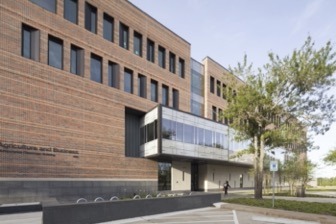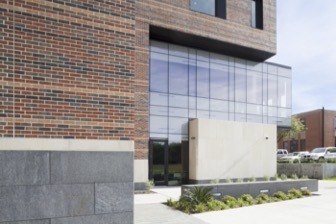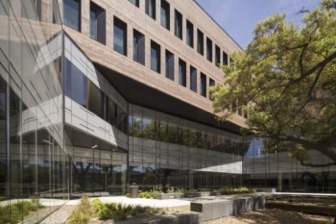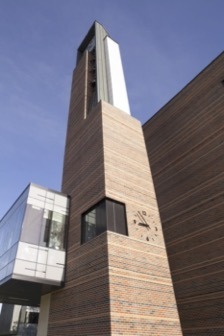Prairie View A&M University’s Agriculture and Business Multipurpose Building
Words: Carrie Snider
Words: Carrie Snider
Photos: Camarata Masonry Systems, Ltd.
About 45 minutes outside of Houston is the second-oldest public institution of higher learning in Texas—Prairie View A&M University. Established after the Civil War during the reconstruction era, it became the first college for African Americans supported by the state.
Even from its beginnings in 1876, Prairie View A&M University focused on agriculture, mechanics, and service. A few years later, in 1879, the state legislature designated Prairie View as a “Normal School” to train teachers.
The school continued to expand its academic offerings year after year. Beginning in 1919, students there could earn four-year degrees. In 1937 they could earn graduate degrees, namely master’s in agricultural economics, rural education, agricultural education, school administration and supervision, and rural sociology. Always, Prairie View A&M focused on diversity and inclusion and making education available to as many as possible.
As the land for the school was initially purchased from the Alta Vista Plantation, the college was first called the Alta Vista Agriculture & Mechanical College for Colored Youth. Its name changed several times over the years and officially became Prairie View A&M University in 1973.
In the 1980s, the Texas Legislature acknowledged the university’s tradition of service and added the school as a beneficiary of the Permanent University Fund, making it an “institution of the first class.” In 2000, the Governor signed the Priority Plan, which made Prairie View an education asset accessible to all Texans, continuing the university’s mission of access and diversity.

Today, about 8,000 students from across the country and even some foreign countries attend the university, with more than 2,000 graduate students on campus. The school is situated on 1,400 acres with 50 buildings—including one significant building added to Prairie View just a few years ago.
Creating A Place for Students to Connect
While students attend college to earn a degree and ready themselves for future employment, there is another crucial element they seek—connection. College students want their university years to include experiencing new things, meeting new people, and making lasting connections.
Historically, much of Prairie View’s social activity took place at “The Hill,” an outdoor gathering space in the middle of campus. Unfortunately, any planned events or casual meetings there were at the mercy of the elements. If there was wind or rain or otherwise bad weather, students were forced to go their separate ways in smaller groups and seek shelter inside different buildings.
But that recently changed when Prairie View looked to construct new agriculture and business buildings. While rooms of instruction, labs, and meeting rooms were in the construction plans, it also became clear that students also needed something more—an indoor “hub” or a prominent gathering place for student events as well as more casual spots to sit and chat, work on homework, and create memories. And since the new building was going to be located in the heart of campus (centralized near “The Hill”), it just made sense to include an indoor spot for students to gather.
Planned at 96,000 square feet, the new L-shaped Agriculture and Business Multipurpose Building was a massive undertaking. Its exterior design harkened back to a traditional university construct with its brickwork while bringing in a modern look with a band of glass around the bottom—allowing students inside and outside to see each other. A series of porches built outside add a connection from indoor to outdoor as well.

The building’s interior includes classrooms and labs, of course, plus the upper floors house the Small Business Development Center and Center for International Business Education. In addition, a two-level, 400-seat auditorium was planned to support the two colleges. With all of this, the Agriculture and Business Multipurpose Building truly would be set to accomplish a lot for the students of Prairie View.
Total construction costs came in at $29 million, with Linbeck Group, LLC as the general contractor, Overland Partners as the architect, Studio 8 as interior design, and Coleman & Associates as the landscape architect.
Challenging Masonry Work
The new building needed to do a lot of things, one of which being to stand out. That meant that masonry work would take center stage. Masonry work for the building was completed by Camarata Masonry Systems (CMS) of Houston.
In all, CMS installed over 217,000 modular bricks and over 8,000 square feet of natural stone. Kevin Camarata, founder, and CEO of Camarata Masonry Systems Ltd. explained that CMS supplied and installed the following for the project:

- 1,110 pieces of three-inch-thick honed Texas Lueders limestone, ranging from 1’-7 5/8” to 2’-5 5/8” wide by 3’-11 5/8” tall
- 240 pieces of mitered honed Lueders limestone window surrounds
- 3,600 square feet of three-inch-thick honed Chinese Basalt measuring 2’ tall by 5’ wide
- 2,500 square feet of one-and-a-half-inch thick honed Chinese Basalt measuring 2’ tall by 5’ wide
- 5,400 8” x 8” x 16” regular lightweight CMU
- 23,100 ACME ELP 274 Mission Pink modular brick
- 26,500 ACME DVP 110 Onyx modular Velour brick
- 38,325 ACME TUP3 Garnet modular Velour brick and 129,150 ACME TUP/DVP 888 modular Velour brick blend (consisting of 45% Garnet, 45% Tuscany, and 10% Onyx)
CMS masonry workers faced many challenges during the project. For one thing, many colors of bricks were used in different blends at specific elevations of the building. Some of the bands of colors are extremely close together. They could easily be misplaced, Camarata explained, so CMS produced shop drawings showing the exact positioning of each brick band and provided each mason with drawings for that day’s work, ensuring proper positioning.
The wide range of materials required for the project also proved challenging, not to mention their sheer size. Some of the basalt and limestone pieces weighed approximately 400 pounds. According to Camarata, many of the base pieces required field modification to accommodate fluctuating site conditions.
The windows were an integral feature of the building, but they posed their challenges as well. Limestone around the narrow windows was mitered on all sides to create its clean look. Also challenging was working around existing ancient oak trees, but the effort was worth it as they marry a mature part of campus to the new building and greet those who enter.

Part of the building includes an impressive clock and bell tower, which offers a focal point for the building and even the campus at large. Construction on the tower was not without its challenges, however. The tall, narrow structure is intricate with brick starting on all sides, then disappearing on two sides at a particular elevation, but gain returns. CMS offered top-notch work to make it shine. The result is a time-honored university icon that is new to Prairie View. During significant campus events, the tower will even light up in the school colors.
Color in other parts of the building will also help students differentiate between the different colleges. The north-south wing is marked with blue accents for the College of Business, and green accents in the east-west wing signify the College of Agriculture. Other elements found across campus have been incorporated into the new building, helping students make a strong connection as they attend classes and gather in the new hub on campus.